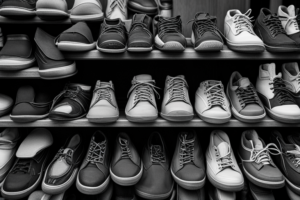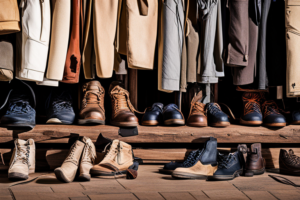
Understanding Sustainable Fashion
Sustainable fashion, you’ve probably heard the term, right? But what does it really mean? Well, it’s not just a buzzword. It’s a movement, a philosophy, a way of life. It’s about creating and consuming clothes in a way that’s, well, sustainable.
It’s about protecting the environment and the people who make our clothes. It’s about cutting CO2 emissions, reducing waste, and supporting biodiversity. It’s about fair wages and safe working conditions. Sounds complex, doesn’t it? But it’s crucial.
But here’s the kicker: just buying ‘sustainable’ labeled items isn’t enough. We need to rethink our purchasing habits and the way we consume clothes.
And no, sustainable fashion doesn’t mean compromising on style or beauty. As Stella McCartney puts it, “I don’t think that things have to look ugly because they’re organic; why can’t they be beautiful as well?”
So, let’s dive deeper into this world of sustainable fashion. Let’s understand it, embrace it, and make it the norm. Because the future of fashion is sustainable. And that future starts with us.
The Importance of Sustainable Fashion
Now, you might be thinking, “Why all this fuss about sustainable fashion?” Well, let me tell you, it’s not just about looking good in organic cotton. It’s about much more than that.
You see, the fashion industry is a major player in the global economy. But it’s also a major player in global pollution. It’s responsible for a whopping 10% of the world’s carbon emissions. That’s more than all international flights and maritime shipping combined.
And it’s not just about the environment. It’s about people too. It’s about ensuring fair wages and safe working conditions for the people who make our clothes.
But here’s the real kicker: as consumers, we have the power to drive change. By choosing sustainable fashion, we’re voting with our wallets. We’re saying, “Hey, we care about the planet and its people. And we want our clothes to reflect that.”
So, the importance of sustainable fashion? It’s about shaping a better, more sustainable future for us all. And that, my friends, is something worth dressing up for.
The Current State of Sustainable Fashion
Did you know that the fashion industry is responsible for 10% of the world’s carbon emissions? That’s more than all international flights and maritime shipping combined. Shocking, right?
But here’s the thing: the fashion industry is changing. And it’s changing fast.
Today, we’re seeing a shift towards sustainable fashion. More and more brands are waking up to the environmental and social impact of their operations. They’re cutting CO2 emissions, reducing waste, and supporting biodiversity. They’re ensuring fair wages and safe working conditions for their workers.
But it’s not all rosy. The road to sustainability is fraught with challenges. Overproduction, pollution, and a lack of transparency are just a few of the hurdles that the industry needs to overcome.
And that’s what we’re going to explore in this section. We’re going to take a hard look at the current state of sustainable fashion. We’re going to delve into the progress that’s been made, the challenges that remain, and the role that we, as consumers, can play in driving change.
So, buckle up. It’s going to be an enlightening ride.

Leading Brands in Sustainable Fashion
Let’s talk about the trailblazers, the pioneers, the ones leading the charge in sustainable fashion. These brands are not just talking the talk, they’re walking the walk.
First up, we have Cotopaxi. Their CEO, Davis Smith, is all about promoting sustainability through design. They’re committed to producing durable apparel as ethically and sustainably as possible. And they’re using their business model to support communities in need. Talk about a win-win!
But they’re not alone. There are a number of responsible fashion brands in the US that are making waves in the industry. They’re reducing their impact on the planet and meeting the growing demand for sustainable fashion.
And let’s not forget about the brands that are investing in organic, recycled, and innovative materials. They’re building responsible supply chains and fighting against greenwashing.
These brands are showing us that sustainable fashion is not just a trend, it’s a necessity. And they’re leading the way towards a more ethical and sustainable fashion industry. So, let’s give them the recognition they deserve.
Challenges in Sustainable Fashion
Now, let’s get real. Sustainable fashion isn’t all sunshine and rainbows. It’s a tough nut to crack. And there are some serious challenges that we need to tackle.
First off, there’s the issue of overproduction. The fashion industry is notorious for producing more clothes than we can possibly consume. And this leads to a whole lot of waste.
Then, there’s the problem of greenwashing. Some brands claim to be sustainable, but when you dig a little deeper, you find that their practices are anything but. It’s a deceptive tactic that can make it hard for consumers to make informed choices.
And let’s not forget about the supply chain. It’s complex, it’s opaque, and it’s often riddled with unethical practices. Ensuring transparency and accountability is a major challenge.
But here’s the thing: these challenges aren’t insurmountable. With the right strategies, the right mindset, and the right commitment, we can overcome them. And that’s what we’re going to explore in the next sections. So, stay tuned.
Interview with Experts
Ever wondered what goes on behind the scenes in the sustainable fashion industry? Who are the people driving this change? What are their thoughts, their insights, their predictions for the future? Well, you’re about to find out.
In this section, we’re going to take you on a journey into the minds of the experts. We’re talking about the trailblazers, the pioneers, the ones who are shaping the future of sustainable fashion.
We’ve had the privilege of sitting down with some of the leading figures in the industry. We’ve asked them the tough questions. We’ve delved into their strategies, their challenges, and their hopes for the future.
And let me tell you, their insights are nothing short of enlightening. They’ve shed light on the realities of the industry, the progress that’s been made, and the work that still needs to be done.
So, get ready. This is your backstage pass to the world of sustainable fashion. It’s going to be a fascinating ride.

Expert Views on Sustainable Fashion
Let’s dive into the minds of the experts, shall we? These are the folks who eat, sleep, and breathe sustainable fashion. They’re the ones who are shaping the industry, one sustainable garment at a time.
First off, we have Stella McCartney. She’s a powerhouse in the world of sustainable fashion. And she’s got a clear message: sustainable fashion doesn’t have to be boring. It can be beautiful, desirable, and luxurious.
Then, there’s Josephine Philips, the founder of a sustainable fashion brand. She’s all about changing perspectives. She believes that we need to rethink the way we consume clothes. We need to understand that our choices have consequences and that we have a responsibility to make better ones.
And let’s not forget about the sustainability consultancy Eco-Age. They’re advocating for a ‘buy less, buy better’ approach. They’re encouraging consumers to ask themselves the tough questions before making a purchase.
These expert views give us a glimpse into the future of sustainable fashion. And it’s a future that’s not just sustainable, but also stylish, ethical, and responsible.
Expert Predictions for the Future of Sustainable Fashion
Now, let’s take a peek into the crystal ball. What does the future hold for sustainable fashion? Well, according to the experts, it’s looking pretty bright.
First up, we have Brooke Roberts-Islam of Techstyler. She believes that the future of fashion lies in technology. She envisions a world where clothes are made from recycled or biodegradable materials, where waste is minimized, and where the supply chain is transparent and ethical.
Then, there’s Stella McCartney. She predicts a future where sustainable fashion is the norm, not the exception. She sees a world where consumers demand sustainability, where brands are held accountable for their actions, and where the fashion industry is a force for good.
And let’s not forget about the founder of a sustainable fashion brand. She foresees a future where fashion is slow, not fast. Where quality trumps quantity, and where consumers make conscious choices.
These predictions paint a hopeful picture of the future. A future where sustainable fashion isn’t just a trend, but a way of life. And that, my friends, is a future worth striving for.
The Future of Sustainable Fashion
Imagine a world where every piece of clothing you own is not just stylish, but also sustainable. A world where fashion doesn’t harm the environment or exploit workers, but instead, contributes to a healthier planet and a fairer society. Sounds like a dream, right? But here’s the thing: this dream is slowly turning into a reality.
In this section, we’re going to explore the future of sustainable fashion. We’re going to delve into the emerging trends, the innovative solutions, and the exciting possibilities that lie ahead.
We’re going to hear from the experts, the visionaries, the ones who are pushing the boundaries of what’s possible in sustainable fashion. We’re going to learn about their hopes, their dreams, and their predictions for the future.
And let me tell you, it’s going to be a fascinating journey. A journey that will challenge your perceptions, broaden your horizons, and inspire you to be a part of the change.
So, are you ready to step into the future of sustainable fashion? Let’s get started.

Emerging Trends in Sustainable Fashion
Let’s talk about the future, shall we? The future of sustainable fashion, that is. And let me tell you, it’s looking pretty exciting.
First off, we have the rise of recycled materials. Brands are getting creative with waste, turning old plastic bottles, fishing nets, and even coffee grounds into stylish, sustainable garments. It’s a trend that’s not just reducing waste, but also pushing the boundaries of what’s possible in fashion.
Then, there’s the shift towards slow fashion. Consumers are starting to reject the fast fashion model, opting instead for quality over quantity. They’re investing in timeless pieces that last, reducing their environmental footprint in the process.
And let’s not forget about the growing demand for transparency. Consumers want to know where their clothes come from, who made them, and what impact they have on the planet. And brands are responding, offering unprecedented insight into their supply chains.
These trends are shaping the future of sustainable fashion. They’re driving change, challenging norms, and paving the way for a more sustainable fashion industry. And that, my friends, is something to get excited about.
How Consumers Can Support Sustainable Fashion
So, you’re probably wondering, “How can I, as a consumer, support sustainable fashion?” Well, let me tell you, it’s easier than you might think.
First off, you can start by buying less and buying better. It’s a simple mantra, but it’s powerful. Before making a purchase, ask yourself: “What am I buying and why? Do I really need it? Will I wear it at least 30 times?”
Then, there’s the option of supporting sustainable fashion brands. These are the brands that are committed to reducing their environmental impact and ensuring fair wages and safe working conditions for their workers.
And let’s not forget about the importance of quality. Investing in high-quality garments that last is not just good for your wallet, it’s good for the planet too.
Finally, don’t be afraid to ask questions. Ask brands about their materials, their supply chains, and their sustainability practices. The more we demand transparency, the more brands will be held accountable.
So, there you have it. Supporting sustainable fashion isn’t just about making a purchase. It’s about making a statement. It’s about saying, “I care about the planet, and I want my clothes to reflect that.”
FAQ
What is sustainable fashion and why is it important?
Sustainable fashion, also known as eco-friendly or environmentally friendly fashion, is a philosophy and movement that advocates for the creation and consumption of clothes in a manner that is sustainable and minimally harmful to the environment. It’s about protecting both the environment and the people who produce our garments. This includes efforts to cut CO2 emissions, address overproduction, reduce pollution and waste, support biodiversity, and ensure that garment workers are paid a fair wage and have safe working conditions.
The importance of sustainable fashion lies in its potential to contribute to the preservation of the environment, ecosystems, wildlife, and human health. The fashion industry is a significant contributor to global greenhouse gas emissions, and changes in the way we produce and consume fashion are necessary. As consumers, our choices about the clothes we buy and the brands we support can drive change in the industry. By choosing sustainable fashion, we are making a statement about our values and contributing to a more ecological and ethical approach to fashion.
Who are the leading brands in sustainable fashion?
There are several leading brands in sustainable fashion that are making significant strides in promoting eco-friendly practices. Cotopaxi, led by CEO Davis Smith, is one such brand that is dedicated to promoting sustainability through design. Their commitment, known as “Gear for Good“, is to produce durable apparel as ethically and sustainably as possible, while also supporting communities in need.
Another notable brand is Patagonia, which is renowned for its wide range of high-quality clothing that performs well while causing minimal harm to the planet. The brand’s dedication to using 98% recycled materials and its transparent approach to environmental impact has made it a company that truly values the health of the planet.
Outerknown is also setting the bar high in the fashion industry with 90% of its fibers being organic, recycled, or regenerated. They believe in creating excellent-quality, sustainable products that last a lifetime, with the goal of keeping their garments out of landfills and in circulation forever.
Lastly, tentree, under the leadership of CEO and Co-Founder Derrick Emsley, is a brand for which sustainability isn’t just a buzzword – it’s a way of life. The company has been carbon neutral since 2020, and their commitment to protecting the planet is evident in everything they do.
What are the current challenges in sustainable fashion?
The current challenges in sustainable fashion are numerous and complex. One of the primary issues is overproduction. The fashion industry is known for producing more clothes than we can consume, leading to a significant amount of waste.
Another challenge is greenwashing, a deceptive tactic where brands claim to be sustainable when, in reality, their practices are far from it. This lack of transparency makes it difficult for consumers to make informed choices and support genuinely sustainable brands.
The complexity and opacity of the supply chain also pose a significant challenge. Ensuring transparency and accountability across the entire supply chain, from raw material sourcing to garment production, is a daunting task.
Moreover, the industry is grappling with the issue of textile waste. With fast fashion leading consumers towards an increased rate of purchasing and a trend to keep clothing for an ever shorter time, the resulting rise in clothing disposal is a major concern.
Lastly, there’s the challenge of changing consumer behavior. Fashion is often about being trendy and up-to-date, while sustainability is about being long-lasting, durable, low impact, and eco-friendly. Bridging this gap is a significant challenge that the industry faces.
How can consumers support the sustainable fashion movement?
Consumers can support the sustainable fashion movement in several ways.
Firstly, they can choose to buy less. This approach challenges the excessive consumerism that is prevalent today. By buying fewer but higher-quality items, consumers can reduce the demand for fast fashion and its associated environmental impact.
Secondly, consumers can choose to buy clothes from sustainable brands. These are brands that take into account the environmental and social impact of their production. They use sustainable materials, ensure fair wages and safe working conditions for their workers, and commit to reducing their CO2 emissions.
Thirdly, consumers can ask questions. They can ask brands about their materials, their supply chains, and their sustainability practices. They can seek out brands that openly disclose information about their factories and their policies around wages and working conditions.
Lastly, consumers can support brands that have a positive impact. These are brands that are not just reducing their impact but are actively working towards having a positive impact on the environment.
By making these choices, consumers can drive change in the fashion industry and support the move towards more sustainable practices.




